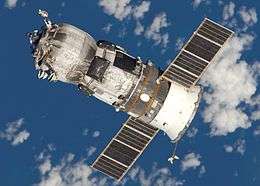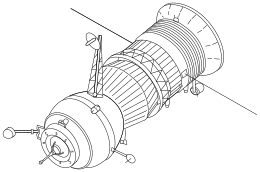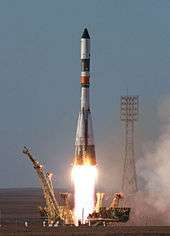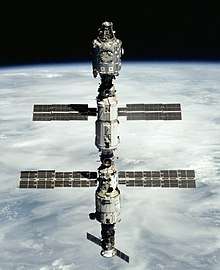Progress (spacecraft)
The Progress (Russian: Прогресс) is a Russian expendable cargo spacecraft. Its purpose is to deliver the supplies needed to sustain a human presence in orbit. While it does not carry a crew, it can be boarded by astronauts when docked to a space station, hence it is classified as crewed by its manufacturer.[1][2][3] Progress is derived from the crewed Soyuz spacecraft and launches on the same vehicle, a Soyuz rocket.
 | |
| Applications |
|
|---|---|
| Specifications | |
| Spacecraft type | Cargo |
| Design life | 6 months docked to a Space Station |
| Payload capacity | 2400 kg |
| Volume | 7.6 m3 |
| Dimensions | |
| Length | 7.23 m |
| Diameter | 2.72 m |
Progress has supported space stations as early as Salyut 6 and as recently as the International Space Station. Each year there are between three and four Progress flights to the ISS. A Progress remains docked until shortly before being replaced with a new one or a Soyuz (which will use the same docking port). Then it is filled with waste, disconnected, and de-orbited, at which point it burns up in the atmosphere. Due to the variation in Progress vehicles flown to the ISS, NASA uses its own nomenclature where "ISS 1P" means the first Progress spacecraft to ISS.
Progress was developed because of the need for a constant source of supplies to make long duration space missions possible. It was determined that cosmonauts needed an inflow of consumables (food, water, air, etc.), plus there was a need for maintenance items and scientific payloads that necessitated a dedicated cargo carrier. Such payloads were impractical to launch with passengers in the restricted space of a Soyuz. As of 4 January 2020, there have been 165 Progress flights with three failures. All three failures have occurred since 2011.
Design
.svg.png)
Progress is of much the same size and shape as Soyuz. It consists of three modules:
- A pressurized forward module. This carries the supplies for the crew such as scientific equipment, clothes, prepackaged and fresh food, and letters from home. The docking drogue is similar to that of the Soyuz but features ducting for the UDMH fuel and N2O4 oxidiser.
- A fuel compartment. The reentry module of the Soyuz was replaced with an unpressurized propellant and refueling compartment with ducting along the outside of the spacecraft. This meant that if a leak occurred, the poisonous gas would not enter the station's atmosphere. The fuel is carried in two tanks.
- A propulsion module. The propulsion module, at the rear of the spacecraft, remained unchanged from the Soyuz and contains the orientation engines used for the automatic docking. It may be used to boost the orbit of the station once docked.
Reduction in mass was possible because the Progress was designed to be uncrewed and disposable. This means that there is no need for bulky life support systems and heat shields. A small amount of weight is saved due to the lack of automatic rescue crews system and lack of parachutes. The spacecraft also has no ability to split into separate modules. After undocking, the spacecraft performs a retrofire and burns up in the atmosphere.
Versions
There were many small variations between the different flights, but the major upgrades are reflected in the change of name.
Progress (1978–1990)

There were 42 spacecraft built using the initial Progress design, the last one being launched in May 1990.
The bureau in charge of designing the freighter was TsKBEM (now RKK Energia). They began work on the design in mid-1973, assigning Progress the GRAU index 11F615A15. The design was complete by February 1974, and the first production model was ready for launch in November 1977. Progress 1 launched on 20 January 1978 aboard the same rocket used to launch the Soyuz. It still featured the same launch shroud as the Soyuz, though this was purely for aerodynamic purposes as the launch escape system had been deactivated.
This first version of Progress had a mass of 7,020 kg and carried 2,300 kg of cargo, or 30% of its launch mass. It had the same diameter as the Soyuz at 2.2 metres, but was 8 metres in length—slightly longer. The autonomous flight time was 3 days, the same time as that of the Soyuz ferry. It could spend one month docked. Progress always docked to the aft port of the station it was resupplying (the aft being where the main rocket engines of the station and their tankage, for refueling by the Progress, are located).
- Launch mass: 7,020–7,249 kg
- Mass of cargo:
- ~2,300 kg (before Progress-24)
- ~2,500 kg (from Progress-24)
- Length: 7.94 m
- Diameter of cargo modules: 2.2 m
- Maximum diameter: 2.72 m
- Volume of cargo compartment: 6.6 m3
Progress-M 11F615A55 (1989-2009)

The upgraded Progress M (GRAU: 11F615A55, manufacturer's designation: 7K-TGM) was first launched in August 1989. The first 43 flights all went to Mir; following Mir's re-entry, Progress was used as the resupply vehicle for the International Space Station. As of August 2014, there have been 56 flights to the ISS and more are scheduled.[4]
The Progress M is essentially the same spacecraft as the Progress, but it features improvements based on the Soyuz T and TM designs. It can spend up to 30 days in autonomous flight and is able to carry 100 kg more. Also, unlike the old Progress crafts, it can return items to Earth. This is accomplished by using the Raduga capsule, which can carry up to 150 kg of cargo. It is 1.5 m long and 60 cm in diameter and has a "dry mass" of 350 kg. Progress M can also dock to the forward port of the station and still transfer fuel. It uses the same rendezvous system as the Soyuz, and it features solar panels for the first time.
- Launch mass 7,130 kg
- Cargo mass 2,600 kg
- Dry cargo mass 1,500 kg
- Liquid cargo mass 1,540 kg
- Length 7.23 m
- Diameter of cargo modules 2.2 m
- Maximum diameter 2.72 m
- Dry cargo compartment volume 7.6 m³
- Solar array span 10.6 m
Progress-М 11F615A60 (2008-2015)
A new modification of the Progress spacecraft, with new TsVM-101 digital flight computer and MBITS digital telemetry system,[5] was first launched on 26 November 2008, at 12:38 UTC from the Kazakhstan's Baikonur Cosmodrome spaceport aboard a Russian Soyuz rocket. The first spacecraft of this series was Progress M-01M.
The spacecraft belongs to the so-called 400 series (GRAU: 11F615A60), and all modifications applied to it were subsequently used in the production of new Soyuz-TMA-M[6] crewed spacecraft.
Progress M-27M was launched on 28 April 2015, but communication with the vessel was lost soon after, and it was destroyed as it re-entered the atmosphere on 8 May 2015.[7] The last launch was Progress M-29M
Progress M1 (2000-2004)
Progress M1 is another variant, capable of carrying more propellant (but less total cargo) to the space stations. There have been 11 of these flights.
- Mass: 7,150 kg
- Capacity cargo: 2,230 kg
- Capacity dry cargo: 1,800 kg
- Capacity propellant: 1,950 kg
Progress M2
Progress M2 was a planned variant, which was a proposed design for the proposed Mir-2 space station, but was dropped due to financial issues. The M2 variant would have a larger service module for larger cargo or space station modules and would have been launched on a Zenit rocket as the spacecraft is bigger.
Progress MS (2015-present)
Progress MS is an improved variant which first launched on 21 December 2015.[8] It has the following improvements:[9]
- New external compartment that enables it to deploy satellites. Each compartment can hold up to four launch containers. First time installed on Progress MS 3.
- Enhanced redundancy thanks to the addition of a backup system of electrical motors for the docking and sealing mechanism.
- Improved MMOD protection with additional panels in the cargo compartment.
- Luch Russian relay satellites link capabilities enable telemetry and control even when not in direct view of ground radio stations.
- GNSS autonomous navigation enables real time determination of the status vector and orbital parameters dispensing with the need of ground station orbit determination.
- Real time relative navigation thanks to direct radio data exchange capabilities with the space station.
- New digital radio that enables enhanced TV camera view for the docking operations.
- The Ukrainian Chezara Kvant-V on board radio system and antenna/feeder system has been replaced with a Unified Command Telemetry System (UCTS).
- Replacement of the Kurs A with Kurs NA digital system.
Current status


Progress spacecraft are used to resupply the International Space Station as of 2020. Between 1 February 2003 and 26 July 2005, they were the only spacecraft available to transport large quantities of supplies to the station, as the Space Shuttle fleet was grounded after the breakup of Columbia at the end of STS-107. For ISS missions, the Progress M1 variant is used, which moves the water tanks from the propellant and refueling module to the pressurized section, and as a result is able to carry more propellant. Progress M-67, the final flight of a Progress-M spacecraft, was launched 24 July 2009 on a Soyuz-U.
On 9 July 2018, Progress MS-09 broke a previous record by reaching the ISS in 3 hours and 48 minutes, carrying about 2450 kg of cargo and supplies. It delivered food, fuel and supplies, including 705 kg of propellant, 50 kg of oxygen and air, 420 kg of water.
The European Space Agency (ESA) operated its own type of robotic supply freighter, the Automated Transfer Vehicle (ATV). The first of these, named Jules Verne, was launched at 04:03 GMT on 9 March 2008. ATVs can carry up to 8.85 tonnes of cargo into space, roughly three times as much as the Progress, and were launched annually by Ariane 5 rockets from 2011-2014 as part of ESA contribution to ISS upkeep. The design is adopted as the Service Module of the Orion spacecraft.
NASA's planned Orion spacecraft was initially designed to have an uncrewed variant of the Crew module similar to Progress, however this capability has been removed on 2009.[10] SpaceX's commercial Dragon spacecraft and Northrop Grumman's Cygnus spacecraft also handle American logistics to the International Space Station.
See also
- List of Progress flights
- Uncrewed spaceflights to the International Space Station
- Comparison of space station cargo vehicles
- Cargo spacecraft – Robotic spacecraft that is designed to resupply a space station
- Automated Transfer Vehicle – Uncrewed cargo spacecraft developed by the European Space Agency
- Cygnus (spacecraft) – Uncrewed cargo spacecraft developed by Orbital Sciences
- SpaceX Dragon – Reusable cargo spacecraft
- H-II Transfer Vehicle – Uncrewed cargo spacecraft developed by JAXA
- Orbital Technologies Commercial Space Station
References
- "Progress". Encyclopedia Astronautica. Retrieved 29 March 2013.
- "Return to selections: 1". Spacecraft Names. Archived from the original on 6 February 2012. Retrieved 29 March 2013.
- "Russian Designations". Encyclopedia Astronautica. Archived from the original on 23 October 2012. Retrieved 29 March 2013.
- "NASA Launch Schedule | NASA".
- "Progress-M 1M - 25M (11F615A60, 7KTGM)". Gunter's Space Page. Retrieved 29 March 2013.
- "Soyuz-TMA 01M - 16M (7K-STMA, 11F747)". Gunter's Space Page. Retrieved 29 March 2013.
- "РОСКОСМОС: ТГК "ПРОГРЕСС М-27М" ПРЕКРАТИЛ СУЩЕСТВОВАНИЕ". federalspace.ru. 8 May 2015. Retrieved 15 December 2015.
- http://sputniknews.com/russia/20151114/1030108241/roscosmos-progress-spacecraft.html
- "Upgraded Progress Transport Cargo Spacecraft Getting Ready for Launch". Yuzhny Space Center. 10 August 2015. Retrieved 13 August 2015.
- Chris Bergin (4 July 2009). "Constellation battle numerous Top Risks – Orion loses unmanned capability". NASASpaceflight. Retrieved 29 March 2013.
External links
| Wikimedia Commons has media related to Progress. |
- NASA - Russian Progress Spacecraft - NASA page discussing the Progress spacecraft, updated May 2005.
- RussianSpaceWeb.com - Progress cargo ship - History, photos and details

